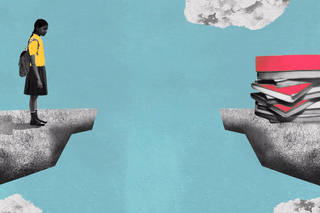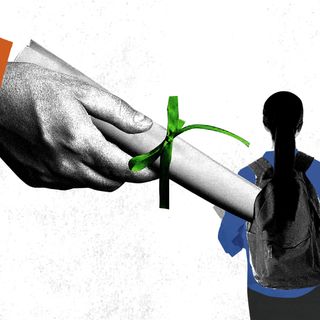
How EdTech Firms Are Capitalizing on the Fear of a ‘Covid Learning Gap’
“I think the use of the education gap as a marketing tactic is really heartbreaking — people buy into that insecurity, definitely.”

Amrita’s eyes dart impatiently towards her 10-year-old son, waiting for a notification to pop on the laptop screen. 2:30 pm, a half-hour delay to the Science class — again — she thinks to herself. At this point, it had been more than 18 months since Nishant attended a class within the beige-plastered walls of a public school in New Delhi.
One question routinely plagues Amrita: How do you make up for education that is lost?
***
Amrita thought of signing up her son for an educational technology platform like Byju’s or Vedantu. Intricately-crafted online classes, these nifty companies claim, will solve the problem of school closures.
And this claim is enough for Amrita. “We would do anything for our children.”
Like Nishant, more than 320 million children have been out of school premises for almost two years now – what is increasingly being referred to as the “Covid learning gap.” But unlike Nishant, a significant number of these children are not getting any form of education at all.
The real “learning gap” thus refers to those children who don’t have access to digital resources and are consequently completely missing out. However, for edtech firms, using the “learning gap” as a catchphrase serves as a highly effective marketing tool to sell more. “I think the use of the education gap as a marketing tactic is really heartbreaking — people definitely buy into that insecurity,” says Vanshika Singh, a researcher at an NGO working in the education sector. Nothing quite sells like fear.
Last month, for instance, Byju’s carried out an advertisement with the assertive lines: “The ‘Covid Learning Gap could affect your child’s future. Let’s fill this gap together.” Bold, persuasive words.
The assumption here is that students who have access to digital resources and money to take endless paid subscriptions are the only ones being affected by the pandemic. But therein lies a paradox. The claim is to fix the global learning gap, created due to a digital divide, by offering more online classes.
Some studies already show how the use of edtech may exacerbate the unequal impact of school closures on student learning; as more semi-privileged and elite students opt for these parallel models, others will either be pushed into debt or continue to be excluded from the knowledge gap discourse.
Moreover, the term learning gap in itself misses a lot of things; the concern spills beyond whether teachers are taking classes, or if students have devices. “One of the biggest challenges in peri-urban areas has been the provision of electricity – a lot of places don’t really get electricity all day round, or they have a fixed time here,” adds Vanshika. According to a 2020 survey conducted by NCERT, almost 28% of students lacked access to proper electricity. Further, according to the 2021 Annual Status of Education Report (ASER), the foundational reading level among underprivileged students surveyed between classes 1-7 was “lower than at any time in the last decade.”
The pandemic has placed children two years behind on their learning targets. However, experts say government school kids were already on average four years behind due to poor infrastructure. To put this in perspective: underprivileged children entering grade nine will effectively be still in grade three. That’s an alarming picture that no one is quite painting yet.
Related on The Swaddle:
Ensure All Children Have Access to Online Classes, Digital Divide of “Great Concern”: Karnataka HC
The stage is thus set for edtech platforms to respond to this gnawing anxiety during the pandemic. “[The rise of edtech] is mainly because of these tensions students and parents face,” says Eldho Mathews, a senior education policy researcher. “Moreover, because these companies are good at marketing, parents might think that by just subscribing to these products, these students could compete in the future.”
For disquieted parents, who otherwise have no recompense for the lost education, these pervasive marketing claims serve as piecemeal answers. “We wanted to subscribe to them so that our children move ahead in life, get educated enough, and make up for what they lost,” says Amrita wistfully. Ultimately, these services were too expensive for her as well.
“This Covid19 situation has helped these companies expand,” Mathews says. In 2021, EdTech companies grew in market share by 70% (as compared to 45% the year before). “They’re marketing people, and they’re utilizing this situation to sell their products.”
***
These platforms sell a dream — one of a perceived gap in the consumerist market. But this time, a gap in pedagogy does exist, which makes their efforts to sell edtech as the solution that much more insidious.
Creating aspiration is an important part of this fear-based marketing. When edtech platforms frame a dream, they create a dichotomy between what students need versus what these companies claim these students need. Think coding, upskilling, getting “exam ready” – a range of courses that can cost up to Rs. 2 lakh.
Although not many can afford the fees for these services, the assumption that they are only being marketed to those who can afford them is false. Anxious parents and students from all socio-economic strata form a tempting target audience. Vanshika, who teaches in the districts of Koregaon and Prahladpur in New Delhi, chuckles while talking about how every student in her class knows of at least Byju’s.
“Students end up not knowing about the free apps or the free classes that they can access on YouTube … because these companies advertise so aggressively, even in the newspaper, it ends up being in students’ and parents’ faces,” she says. A report by Avanti Fellows, an NGO working in the education sector, recently found that the exposure of these apps in peri-urban areas doubled from 24% to 52% in the last year. But at the same time, the time spent on these platforms remained low – somewhere between two-three minutes. This could be due to the limited scope of study material or the paid packages within these apps.
In some cases, these apps exploit low-income parents through loan-based subscriptions, resulting in people being pushed into debt. Vanshika recalls a viral LinkedIn post: a Byju’s teacher regaled about how happy he felt on realizing his students had put up a picture of him — next to God. He was very touched. The family had actually taken a loan to get that module subscription. A report in Rest of the World also painted a worrying picture of the trend: “a punishing internal culture based around profiling clients, hard-sell tactics, and unattainable targets” inevitably means “selling products to underprivileged families who cannot afford them.”
Pradeep Poonia, an education activist and a whistleblower of the Byju’s aggressive sales operations, points to the neat formula these platforms tend to apply. “These marketing people come and persuade parents to subscribe to a product. And after three or four days, mostly the parents are not happy with the quality, and then they request this company for cancellation.” However, cancellation requires writing an email in English – and a lot of parents neither know how to write an email or English.
Making anxious parents jump through the wringer is morally dubious in every which way but, for underprivileged parents, it reeks of exploitation.
***
There was a gap in education even before the pandemic – the global crisis just spotlighted it. “Think of it this way: there was like a huge building with a lot of cracks. And somebody put a lot of pressure on that building. Now it’s breaking down,” says Vanshika.
Related on The Swaddle:
Karnataka Government Bans Live Online Classes for Kids Up to Grade 5
When asked what is missing from the conversation about the Covid learning gap, Akshay Saxena, co-founder of Avanti Fellows, asks, “What’s in the conversation?” half-amused. “The biggest thing people don’t recognize enough is that most kids would have learned nothing.” There’s very little evidence that beyond elite students, [anyone] has learned anything meaningful from a competency perspective over the last two years. “The truth of it is likely that most kids are going to be two years behind when they come back to school. That in itself has some significant knock-on effects.”
Moreover, there is also a lack of understanding around the scale of the learning gap. Two years into the pandemic, there is still simply not enough data around how deeply Covid19 impacted students’ learning. The central government recently admitted to not having this record; how many students, of what age groups, across which geographical areas, struggling with specific learning challenges.
“The serious thing that’s missing is a longitudinal study about the impact of Covid19 on things like class time sections or the teaching-learning process,” Eldho Mathews says. “Everything in the school sector depends on perception. We don’t know much about what’s happening inside the schools…”
Collecting data through monitoring standardized tests is also a process riddled with loopholes. “A lot of teachers are tampering with those results to make sure that it looks like that students are coming to school, or that students are not actually impacted, or that the gap is not as wide,” Vanshika points out. In other words, there’s a grassroots attempt to not let out the severity of this education gap. If the baseline data is itself so polluted, Vanshika notes, then any efforts towards covering up that gap will be tokenistic at best, absent at worst.
Recently, the government proposed restricting the kind of claims edtech companies make. However, the companies protested this, saying they will “self-regulate” themselves. “The same people who created all the problems will now clear the problems. They’re not going to do it. It’s just a tactic,” says Pradeep Poonia. This is not the same for other countries, which have stringent laws about what kind of claims these private players make.
Parents — and children — are then left at the mercy of the markets. Akshay also believes that we should treat education with a similar lens as healthcare. Just like you won’t allow marketing of unproven drugs to children, he says, there needs to be some check and balance on what companies are allowed to tell parents and students.
***
The solution, in the end, points to a glaring need to provide a free, high-quality alternative to these exploitative education services. Vanshika notes that the current digital material given by the government – in the form of e-books and apps – is clunky to use, has average content quality, and mostly fails in terms of infrastructure. Also, there remains limited awareness about these government offerings.
The lack of government interventionsignificantly contributes to the void in which for-profit education thrives. According to Akshay, this is similar to the overall crisis in school education – if government schools are bad, people are going to private schools no matter how economically or logistically straining they are. The promise of it, he says, ends up being more important than the value of it.
“The problem is there is no alternative – what will the parents do? They will buy something or the other,” he says. “If we, as a country, don’t invest in free public education – both online and offline – this is going to keep happening.”
Saumya Kalia is an Associate Editor at The Swaddle. Her journalism and writing explore issues of social justice, digital sub-cultures, media ecosystem, literature, and memory as they cut across socio-cultural periods. You can reach her at @Saumya_Kalia.
Related


Legal Controversy Over ‘Gangubai Kathiawadi’ Shows How Marginalized People’s Stories Are Appropriated
